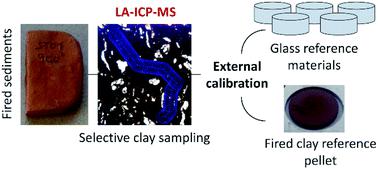当前位置:
X-MOL 学术
›
J. Anal. At. Spectrom.
›
论文详情
Our official English website, www.x-mol.net, welcomes your
feedback! (Note: you will need to create a separate account there.)
Multi-element LA-ICP-MS analysis of the clay fraction of archaeological pottery in provenance studies: a methodological investigation
Journal of Analytical Atomic Spectrometry ( IF 3.1 ) Pub Date : 2020-09-11 , DOI: 10.1039/d0ja00286k Marieke Vannoorenberghe 1, 2, 3, 4, 5 , Thibaut Van Acker 1, 2, 3, 4, 5 , Joke Belza 1, 2, 3, 4, 5 , Dimitri Teetaert 1, 2, 3, 4, 5 , Philippe Crombé 3, 4, 5, 6, 7 , Frank Vanhaecke 1, 2, 3, 4, 5
Journal of Analytical Atomic Spectrometry ( IF 3.1 ) Pub Date : 2020-09-11 , DOI: 10.1039/d0ja00286k Marieke Vannoorenberghe 1, 2, 3, 4, 5 , Thibaut Van Acker 1, 2, 3, 4, 5 , Joke Belza 1, 2, 3, 4, 5 , Dimitri Teetaert 1, 2, 3, 4, 5 , Philippe Crombé 3, 4, 5, 6, 7 , Frank Vanhaecke 1, 2, 3, 4, 5
Affiliation

|
Laser ablation-inductively coupled plasma-mass spectrometry (LA-ICP-MS) is an increasingly popular direct solid sampling micro-analytical technique for multi-element analysis in provenance studies of archaeological pottery. However, the development and use of a reliable quantification strategy for the analysis of pottery clay via ns-LA-ICP-MS is not self-evident due to the lack of commercially available matrix-matched clay reference materials covering a wide range of characterized element concentrations. In this work, the capabilities and limitations of various calibration approaches were evaluated, based on the analysis of NIST SRM 679 Brick Clay as a model sample. Calibration relied on the use of either (i) 5 glass reference materials or (ii) the matrix-matched reference material New Ohio Red Clay (NORC) as external calibration standard(s). Four calibration strategies were compared and it was shown that (a) external calibration without internal standard correction is not suitable when using glass reference materials for calibration, but can be used in the case of calibration against a clay reference material, (b) different sum normalization approaches produce results that are very similar to each other and (c) glass reference materials used as standards in an external calibration approach with internal standard correction or a sum normalization method can provide accurate results for a wide range of major, minor and trace elements. Finally, the utility of an appropriate sum normalization calibration approach was illustrated by analysis of 10 sediments relevant to provenance studies of Final Mesolithic and Early Neolithic pottery in the Scheldt valley and their successful discrimination employing linear discriminant analysis (LDA) based on 44 element concentrations. The use of polished sediment thin sections in combination with transmitted light microscopy enabled the clay fraction of the sediments only to be meticulously sampled. A dedicated outlier rejection protocol was applied to minimize the contribution of non-visible constituents.
中文翻译:

种源研究中考古陶土粘土成分的多元素LA-ICP-MS分析:方法学调查
激光烧蚀-电感耦合等离子体质谱法(LA-ICP-MS)是一种在考古陶器物源研究中用于多元素分析的越来越流行的直接固体采样微分析技术。但是,开发并使用了可靠的定量策略来通过ns-LA-ICP-MS并非不言而喻,因为缺乏可商购的基质匹配的粘土参比材料,其涵盖了各种特征元素浓度。在这项工作中,基于对NIST SRM 679 Brick Clay作为模型样本的分析,评估了各种校准方法的功能和局限性。校准取决于使用(i)5种玻璃参考材料或(ii)与基质匹配的参考材料New Ohio Red Clay(NORC)作为外部校准标准。比较了四种校准策略,结果表明:(a)在不使用内标校正的情况下进行外部校准不适用于使用玻璃参考材料进行校准的情况,但可以用于针对粘土参考材料进行校准的情况,(b)不同的总和归一化方法产生的结果彼此非常相似;以及(c)在具有内部标准校正的外部校准方法中或用作标准的玻璃参考材料或总归一化方法可以为各种主要标准提供准确的结果,次要和微量元素。最后,通过分析与谢尔德山谷中最终中石器时代和新石器时代早期陶器物源研究相关的10种沉积物,并利用基于44个元素浓度的线性判别分析(LDA)成功判别了这些沉积物,说明了适当的总归一化校准方法的实用性。将抛光的沉积物薄片与透射光显微镜结合使用可使沉积物的粘土组分仅被仔细取样。
更新日期:2020-11-03
中文翻译:

种源研究中考古陶土粘土成分的多元素LA-ICP-MS分析:方法学调查
激光烧蚀-电感耦合等离子体质谱法(LA-ICP-MS)是一种在考古陶器物源研究中用于多元素分析的越来越流行的直接固体采样微分析技术。但是,开发并使用了可靠的定量策略来通过ns-LA-ICP-MS并非不言而喻,因为缺乏可商购的基质匹配的粘土参比材料,其涵盖了各种特征元素浓度。在这项工作中,基于对NIST SRM 679 Brick Clay作为模型样本的分析,评估了各种校准方法的功能和局限性。校准取决于使用(i)5种玻璃参考材料或(ii)与基质匹配的参考材料New Ohio Red Clay(NORC)作为外部校准标准。比较了四种校准策略,结果表明:(a)在不使用内标校正的情况下进行外部校准不适用于使用玻璃参考材料进行校准的情况,但可以用于针对粘土参考材料进行校准的情况,(b)不同的总和归一化方法产生的结果彼此非常相似;以及(c)在具有内部标准校正的外部校准方法中或用作标准的玻璃参考材料或总归一化方法可以为各种主要标准提供准确的结果,次要和微量元素。最后,通过分析与谢尔德山谷中最终中石器时代和新石器时代早期陶器物源研究相关的10种沉积物,并利用基于44个元素浓度的线性判别分析(LDA)成功判别了这些沉积物,说明了适当的总归一化校准方法的实用性。将抛光的沉积物薄片与透射光显微镜结合使用可使沉积物的粘土组分仅被仔细取样。











































 京公网安备 11010802027423号
京公网安备 11010802027423号